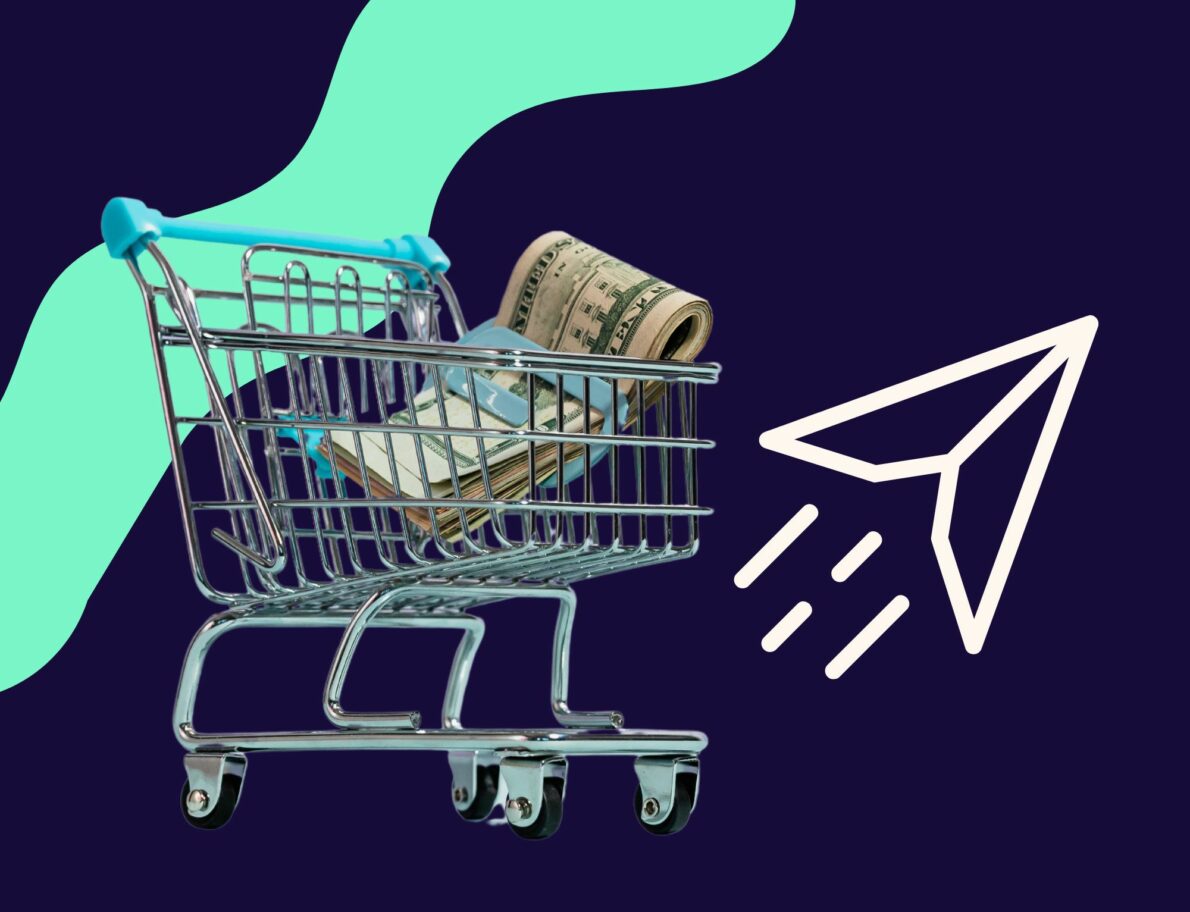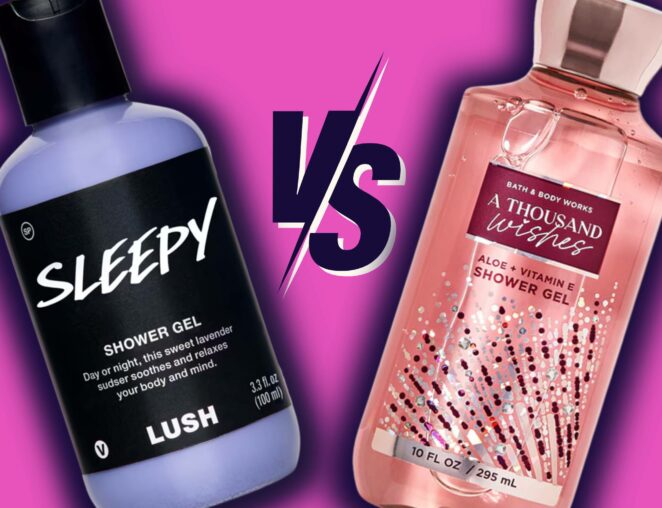What you’ll learn:
- What is an Abandoned Cart Email?
- Abandoned Cart Email Sequences That Work Like a Charm (With Examples)
- 3 Abandoned Cart Email Templates
- How to Write Abandoned Cart Email Sequences that Rake in Revenue
- 13 Reasons Shoppers Abandon Carts
When customers load up their online carts and vanish, it can feel like watching potential profits slip through the digital cracks.💸
While you can’t force customers to complete their purchases, you can tweak your strategy to entice them back. Abandoned cart emails are the perfect way to get them to finish what they started.
We caught up with our founder, Christina Lyon for expert insights on crafting a kickass abandoned cart email strategy.
If you’re ready to say goodbye to ghosted carts and hello to recouped revenue, keep reading!
What is an Abandoned Cart Email?
Abandoned cart email sequences target customers who have added your products to their cart but never completed their purchase. These emails aim to recover lost sales by convincing shoppers to go back to their cart and hit that check-out button.
Abandoned cart emails work by instilling a fear of missing out (FOMO). This is a sense of urgency and scarcity that makes audiences feel they’ll miss out if they don’t act fast.
According to Christina, the best way to do this is to highlight irresistible perks like free shipping, limited inventory, exclusive offers — pretty much anything that sweetens the deal and tempts them back.
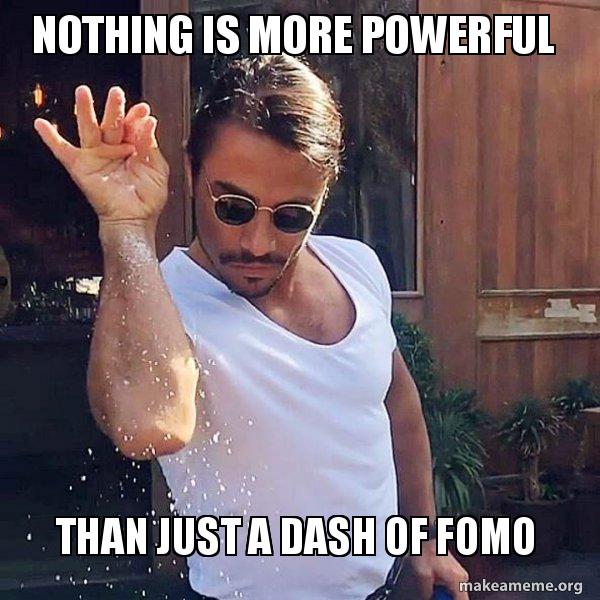
Abandoned Cart Email Sequences That Work Like A Charm (With Examples)
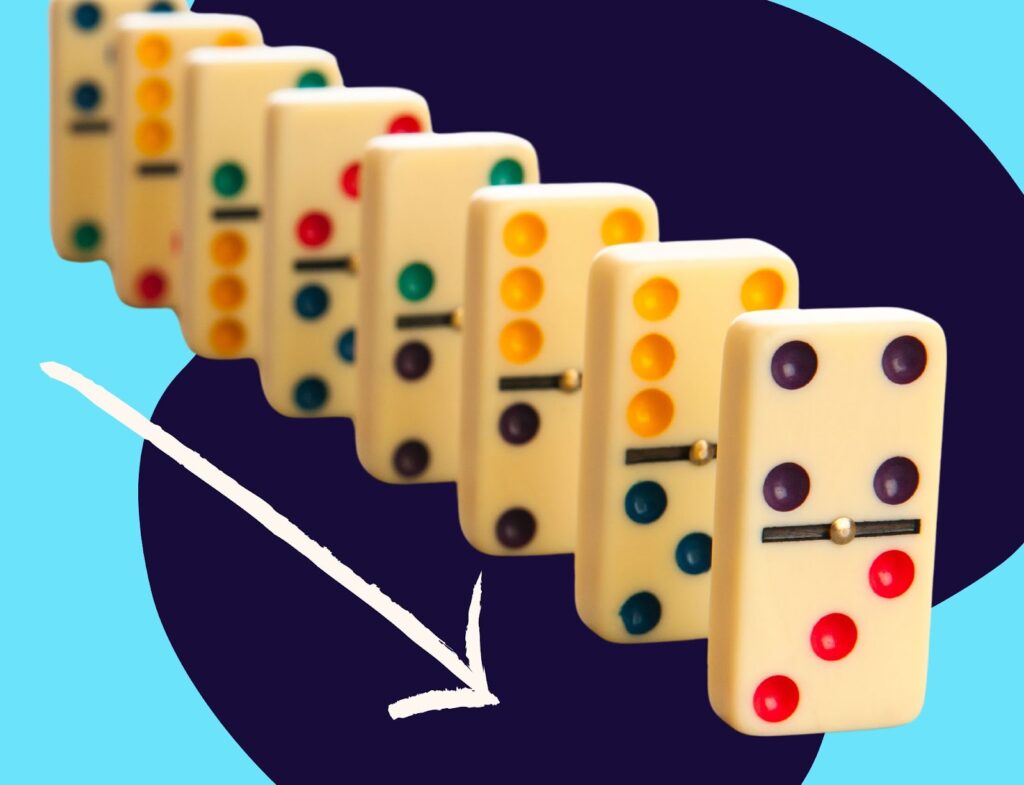
Here’s what the sequence of your messaging typically looks like, along with some abandoned cart email examples from Bean Goods, an e-commerce store that sells dachshund-themed goodies “for radical doxie lovers.”🌭
Have I gone all-in on wiener dog swag for my most handsomest boy? Maybe, but that’s neither here nor there.

Back to our cart email sequences:
First Abandoned Cart Email: The Reminder
After a customer adds products to their cart and then clicks away, this initial email should go out within thirty minutes to an hour.
In this message, remind recipients that they forgot to check out. Let them know you’ve saved their cart so they can come back and finalize their purchase.
For example, you could say you’ve temporarily held their order and that they should check out before it’s gone for good. This emphasis on scarcity sparks a sense of urgency and triggers FOMO.
Example:
Subject line: your perfect op-paw-tunity 🐾
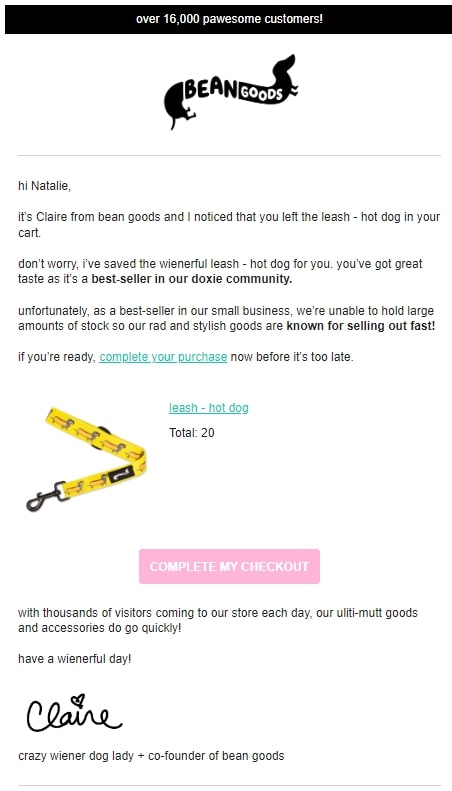
Why it works:
This first email from Bean Goods nails the initial abandoned cart reminder. It kicks off with a personal touch, addressing me by name and letting me know what I left behind. They assure me the item is saved but that it’s a best-seller at risk of selling out. They even go as far as to let me know how many are currently in stock.
The playful, conversational tone perfectly matches Bean Goods’ brand voice, with fun lines like “have a wienerful day!” and “crazy wiener dog lady,” making it engaging and memorable. And, of course, the clear CTA front and center is impossible to miss.
Second Email: The Follow-Up
This second nudge should go out 12 to 48 hours after your initial email.
Use this message to let customers know their cart is about to expire. Use similar content to your first email, but communicate more urgency. This is where most brands sprinkle in a coupon code or relevant product recommendations to draw shoppers back.
For instance, you could tell them this is their last chance to order before that item is officially sold out. You could also throw in a line about how you don’t know if or when you’ll restock, so they better grab it while they can.
Example:
Subject line: still thinking about your wiener? 🌭😳
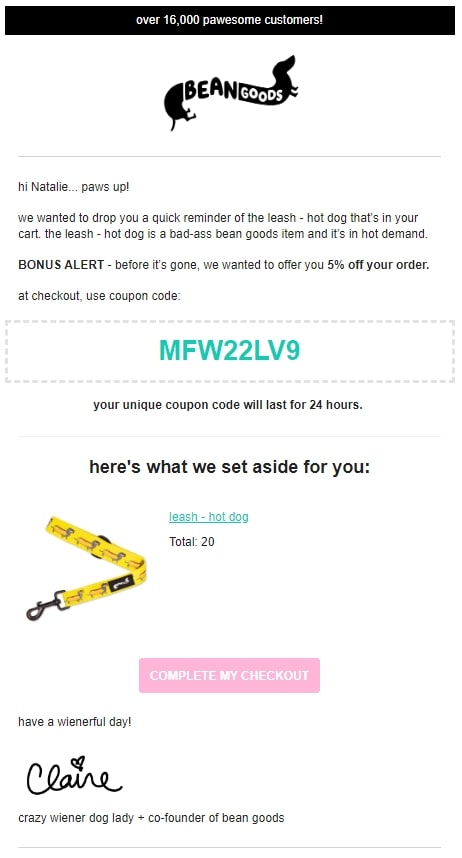
Why it works:
This follow-up email from Bean Goods is a stellar second nudge, keeping its playful vibe while cranking up the urgency.
It starts with a funny subject line and friendly, personalized greeting, reminding me once more what I left behind and highlighting its popularity.
Then they up the ante with a 24-hour 5% coupon code to spur immediate action. The clear CTA and engaging brand voice make it just as memorable and effective as their first email.
Third Email: The Irresistible Deal
Time for your big finish! 🥳This final email should go out a day or two after the previous one.
If the first two messages didn’t do the trick, it’s time to switch gears and give it one last shot at recovering potential sales.
Instead of focusing on scarcity and urgency, use this email to emphasize the benefits of owning your product and your brand’s unique value proposition (UVP).
Reinforce your message with social proof or customer testimonials. And don’t forget to remind recipients of your previous offer, hinting at its possible expiration.
Example:
Subject line: is there anything worse than this? 😱
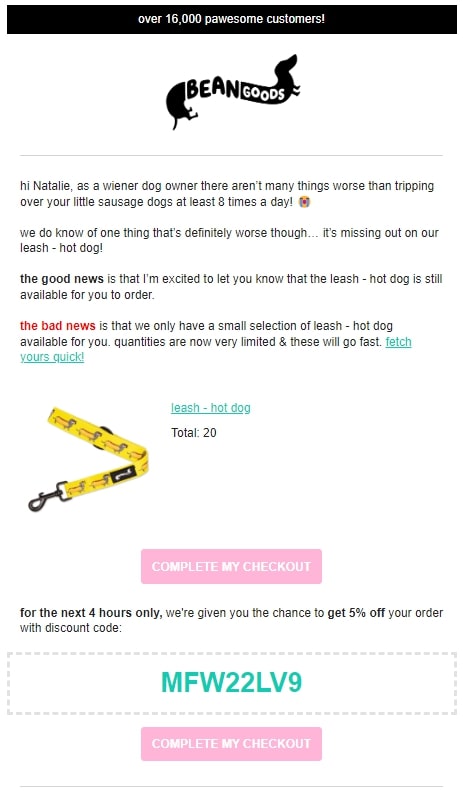
Once more, Bean Goods grabs my attention with a funny, relatable opening sentence, and maintains a friendly, personalized tone. The email stresses the limited availability of the item in question while reassuring me it’s still up for grabs.
They again offer a 5% discount, but this time with a 4-hour window, urging immediate action. The clear CTA and playful language (“fetch yours quick!”) perfectly match Bean Goods’ brand messaging.
Curious if it works? Let’s just say my bank account knows the answer.😅
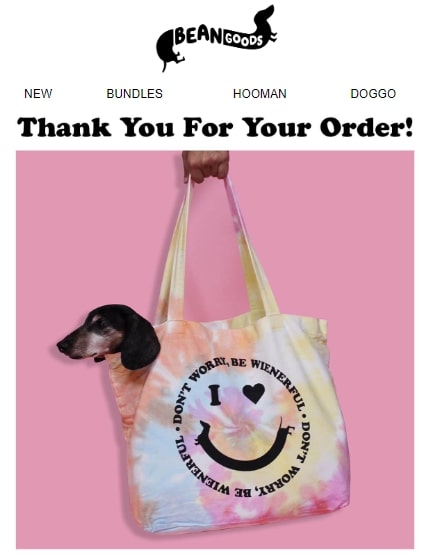
3 Abandoned Cart Email Templates
Oh, you thought we’d drop all these juicy tips and leave you to figure it out solo? Not a chance. 💁🏻♀️
Here are 3 abandoned cart email templates to get you rolling:
1. The Friendly Reminder
Subject line: Oops! You Left Something ⭐Soft & Star-Spangled⭐ Behind!
Email:
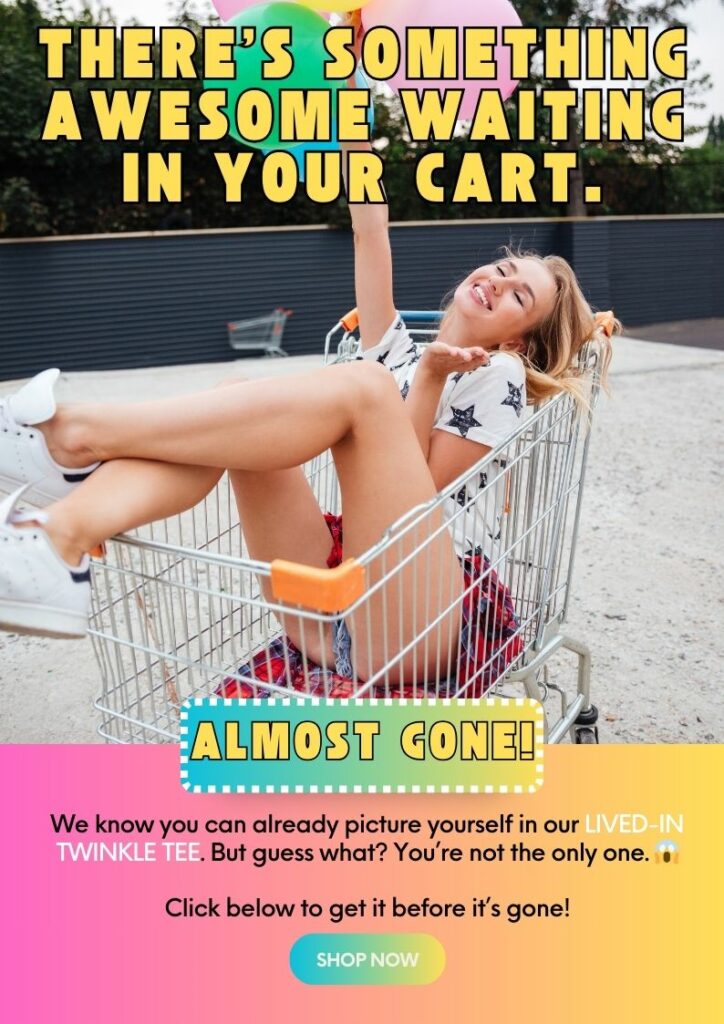
Click here to edit this template in Canva.
2. The Savings Follow-Up
Subject line: Psst… Did Someone Say Flawless Makeup and 10% Off?
Email:
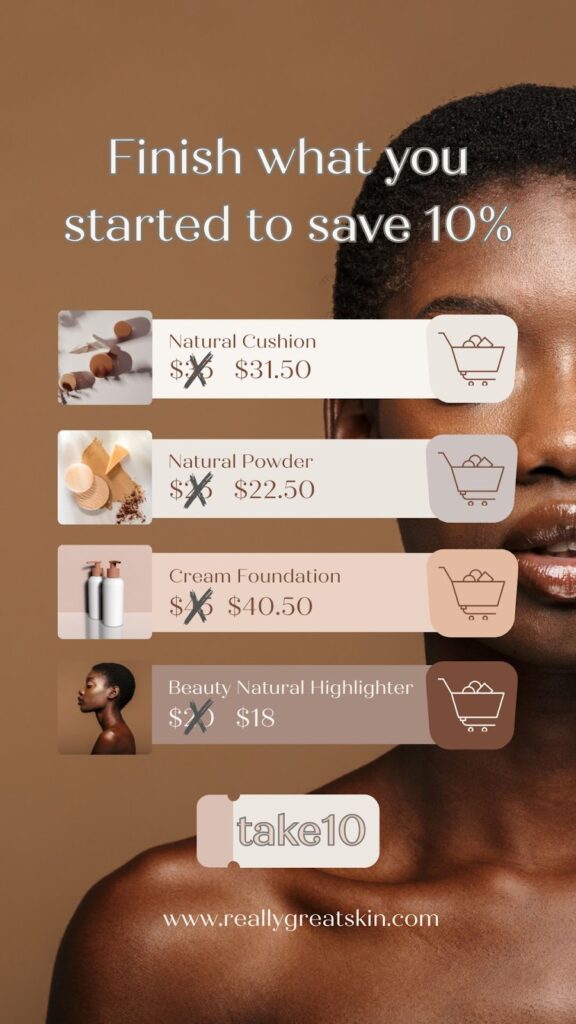
Click here to edit this template in Canva.
3. The Delectable, Soon-To-Be-Gone Deal
Subject line: Last Call for Beaded Beauties! BOGO Ends In 3… 2…
Email:
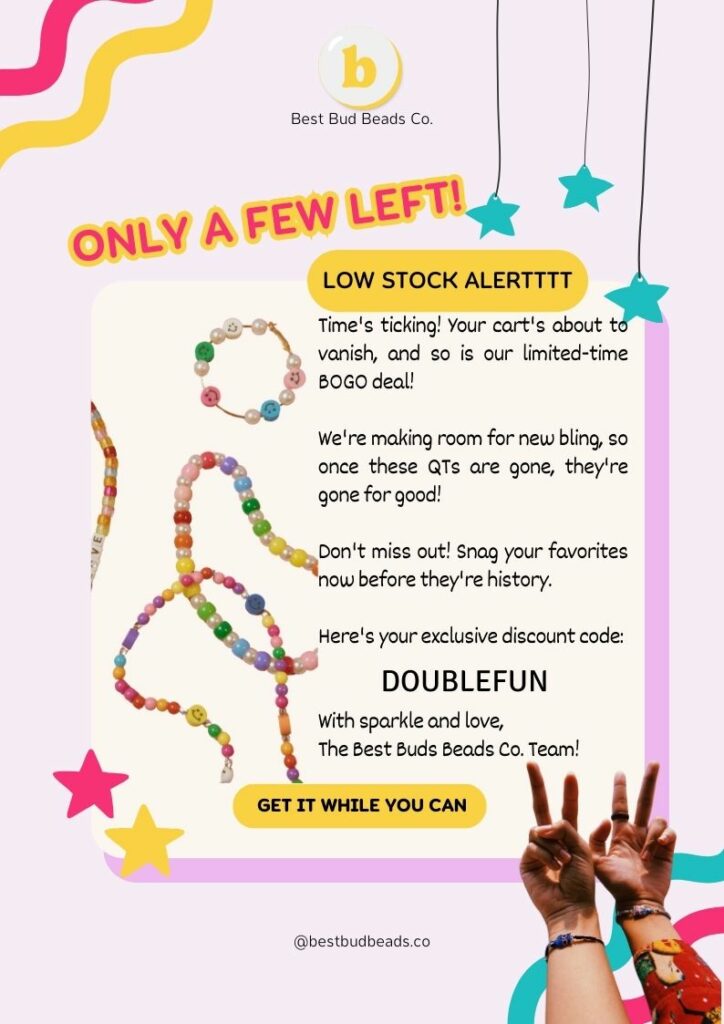
Click here to edit this template in Canva.
So, how do you turn these browsers into bonafide buyers? You’ll need to set up an abandoned cart email strategy they can’t resist.⚡
How to Write Abandoned Cart Email Sequences that Rake in Revenue
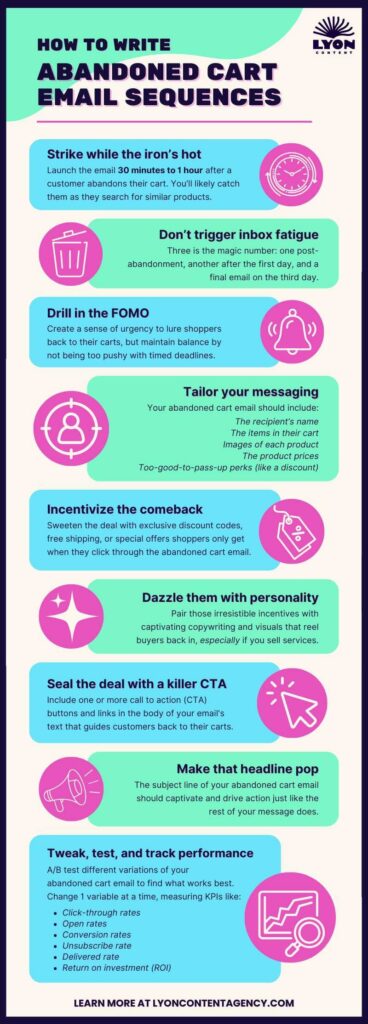
Moosend reports that almost 50% of abandoned cart emails are opened. Nearly half of those get clicked, and half of those clicks turn into purchases. What does it all add up to? A whopping $260 billion in potential sales!
Bottom line: they work if you do them right. Here are some expert tips to get customers to return and complete their purchases:
- Strike while the iron’s hot
- Don’t trigger inbox fatigue
- Drill in the FOMO
- Tailor your messaging
- Incentivize the comeback
- Dazzle them with personality
- Make your headline pop
- Seal the deal with a killer CTA
- Tweak, test, and track performance
Strike while the iron’s hot
The best time to launch an abandoned cart email is thirty minutes to an hour after a customer abandons their cart. This way, you’ll likely catch them while they search for similar products.
Wait longer than that? Christina warns it could be too late:
“The longer you wait, the more chances customers have to click to other sites, create other carts, and forget about you altogether,” she says. Just be careful not to veer into spammy territory.
Don’t trigger inbox fatigue
Wondering, “How many abandoned cart emails should I send?” Christina says that overwhelming customers with nonstop reminder emails is a surefire way to lose sales and make a bee-line to the spam folder.
“Send them a few emails, with some space between each so that your email pops up naturally rather than clogs their inbox,” she says.
Most marketers agree that three is the magic number: one post-abandonment, another after the first day, and a final email on the third day (more on email sequences later).
Drill in the FOMO
Remember how we discussed messaging that creates a sense of urgency to trigger FOMO and lure shoppers back to their carts? This is essential for abandoned cart emails, but balance is key.
Nixing timed deadlines might be a good way to avoid being too pushy, says Christina. But ultimately, it depends:
“There are some instances where you have no choice but to use urgency. For instance, with booking timed events,” she explains. “In this case, go back to your brand messaging and make sure your copy is about them and their pain points, and how you’re helping them; not just about how great your business/product/service is.”
Tailor your messaging
Customers who abandon their carts shouldn’t be hit with the same newsletter you send to your everyday subscribers. This audience requires tailored messaging that speaks to the products they left behind, highlighting unique features, special offers, or shipping discounts to draw them back to their carts and convert.
Your abandoned cart email should include:
- The recipient’s name
- The item in their cart
- Images of each product
- Prices
- Too-good-to-pass-up perks (like a discount)
The more personalized and engaging your approach, the better your chances of turning that lost sale into a satisfied customer.
Incentivize the comeback
Tailored, timely messaging is important, but how are you luring customers back to your online store?
“Sure, your product/service is worth full price, but if shoppers are clicking away, you want to sweeten the deal,” says Christina.
That means offering exclusive discount codes, free shipping, or special offers shoppers only get when they click through your abandoned cart email.
“That little nudge could be exactly what you need to not only make the sale but foster loyalty and get return customers,” she urges.

Dazzle them with personality
It’s safe to assume your competitors are sending abandoned cart emails, too. To stand out, you’ll need to pair those irresistible incentives with captivating copywriting and visuals that reel buyers back in.
And if you sell a service instead of tangible goods? Christina says the stakes can be even higher:
“Services are usually higher investments, so cart recovery emails require even more conversation, storytelling, and bonding with prospective customers,” she explains. “You can do this by sharing a story, social proof, positive results, and top it off with a freebie or bonus on their service.”
Wordplay got your head spinning? Let Lyon Content take the reins.🦁
Make your headline pop
Remember, your customers’ inboxes are crowded with emails from other brands. The more your headlines pique curiosity and interest, the more eager recipients will be to see what’s inside.
Here are some ideas for headlines that are impossible to ignore:
- Hey [Name]! Snag your items before they’re gone!
- Surprise! Your cart has a special offer!
- Still thinking about that [product]? Shipping’s on us!
- Purchase now for instant savings!
- Oops — You left something awesome behind!
Seal the deal with a killer CTA
Within the body of your email’s text, there should be one or more call to action (CTA) buttons and links that guide customers back to their carts. These can vary in style and phrasing according to your brand, but the goal remains the same: get them to finish what they started.
Some common CTA’s for cart recovery emails include:
- Return to cart
- Get your exclusive offer
- Only a few left
- Check out now for free shipping
- Finish what you started for savings
- Complete your purchase
- Get your order now
- Order by midnight and get X% off
Tweak, test, and track performance
A/B testing different variations of your abandon cart email is crucial to find your brand’s sweet spot. This is when you compare two versions to see which one works best.
As for what to test, the sky’s the limit — different designs, copy, CTAs, or abandoned cart email templates.
Just keep in mind, it’s best to change one variable at a time. If you alter too many elements, you might not be able to hone in on which variation hurts or helps your emails’ effectiveness.
Then measure the impact of your emails with key performance indicators (KPIs) like:
- Click-through rates: the percentage of recipients who click through your email
- Open rates: the percentage of recipients who open your emails
- Conversion rates: the percentage of recipients who click on a link in your email and then complete a purchase
- Unsubscribe rate: the percentage of recipients who unsubscribe from your email list after receiving your abandoned cart emails
- Delivered rate: the percentage of emails that successfully reach your intended recipients’ inboxes
- Return on investment (ROI): how much revenue you generate from abandoned cart emails compared to the cost of sending them
Pro tip: tools like Mailchimp, HubSpot, and Brevo are excellent for tracking abandoned cart email marketing performance.
As for why potential buyers bolt before the deal is done, there are a few possibilities.
13 Reasons Shoppers Abandon Carts
Nearly 70% of customers abandon their carts, which means only three in ten actually make it all the way through to the other side. As for the rest, here are a few reasons they might’ve bailed:
- Complicated checkout page
- Better prices elsewhere
- Forced account creation
- Unexpected costs
- Lousy site design
- Limited shipping options
- Excessive upselling
- Insufficient payment options
- No coupon codes
- Security concerns
- Insufficient social proof
- Sub-par return policy
- No intent to purchase
1. Complicated checkout page
A confusing or lengthy checkout process can stop potential customers in their tracks. That’s why many e-commerce stores now opt for single-page checkout pages.
2. Better prices elsewhere
Chances are you’re not the only one selling what you’re selling. If a competitor delivers, you better believe they’ll ghost your biz without a second thought.✌️
3. Forced account creation
When you force customers to register an account mid-checkout, you disrupt the purchase cycle with an extra step. This is a turn-off for about 26% of shoppers, so offer guest check-out and incentivize registration later.
4. Unexpected costs
Surprise costs can make customers rethink purchases and ditch their carts. The fix? Ask for zip codes on the product page to show all costs upfront, including shipping, taxes, and any additional fees.
5. Lousy site design
A poor user experience (UX) is a straight shot to high bounce rates. Slow load times, confusing designs, and displaying prices in a foreign currency can drive shoppers to throw it in the bag elsewhere.
6. Limited shipping options
Delivery is a big part of the online shopping experience. Customers want their pick for shipping and timely delivery, so different shipping options are a must.

7. Excessive upselling
Cross-selling (recommending similar products) and upselling (suggesting upgrades) are smart strategies, but overdoing it can turn customers away just as they’re ready to buy.
8. Insufficient payment options
Online shoppers want the convenience of using their preferred payment method. If they can’t use it, they could bail on their cart when they find out.
9. No coupon codes
E-commerce shoppers are so used to getting flooded with coupons and promo offers that if your brand fails to, they might leave for a better deal.
10. Security concerns
Buyers need to know that your website keeps their personal and financial details secure. Adhere to PCI guidelines, implement fraud management, and display trust seals so visitors know their data is safe.
11. Insufficient social proof
Did you know 95% of customers read online reviews before they commit to a purchase? The more testimonials and social proof your site has, the more shoppers will trust that what they’re buying is worth their investment.
12. Sub-par return policy
Some online stores make returns and exchanges a pain in the you-know-what.🍑 Unsurprisingly, this can cause customers to leave and purchase from competitors with a better policy.

13. No intent to purchase
Sometimes, shoppers abandon carts for reasons that are simply beyond your control. They might be price-checking or scratching the itch of retail therapy without actually wanting to spend any coin (guilty!). Whatever the case, it’s not always your fault.
Catch Those Runaway Sales with Lyon Content
As your online store grows, you’ll get all sorts of shoppers that drop by. Some will grab your offerings without a second thought, while others will load up their carts and totally forget about them — kind of like that text you thought you replied to.
A well-crafted abandoned cart email strategy can help reel these indecisive shoppers back in and guide them to the finish line, turning those abandoned carts into sweet, sweet sales.🤑
Tired of forgotten carts and emails that disappear into the void? Lyon Content’s team of email marketing writers are masters at crafting messages that convert and boost your bottom line.
Hit us up, and we’ll help you turn ghosted carts into converting customers.

07/01/2024
Natalie is a beauty and lifestyle writer at Lyon Content, born and raised in sunny Miami, Florida. She’s passionate about crafting personality-driven copy that helps brands build a ride-or-die following with their audiences! Like a true Cuban, she runs on XL cafe-con-leches and loves horror movies, houseplants, exploring new places, and snuggling up with her SO and fur babies.

